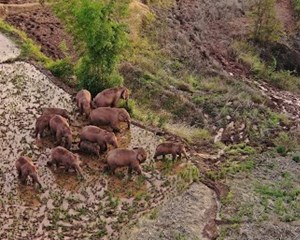(单词翻译:单击)
听力文本
JUDY WOODRUFF: It's not a sight you see every day, a herd of elephants, leaving their home turf, making their way through Southwestern China, most recently stopping in a city of millions. But that is what's happening right now. William Brangham looks at their mysterious trek, and why they might have hit the road in the first place.
WILLIAM BRANGHAM: It's been an epic and highly unusual journey so far, more than 300 miles over the last year, across deserts, through forests, crossing busy city streets, navigating ditches. This herd of 15 Asian elephants is captivating China. Every step of their trek documented on state-run media, and seemingly everywhere on Chinese social media. The world can't seem to get enough of this trip, a trip to -- well, nobody quite knows where. They stop for naps, though the adults seem more tuckered out than their offspring. They eat corn in the fields, even try to break into power plants. But why are they on this journey? I asked conservation biologist Peter Leimgruber that very question at the Smithsonian's National Zoo in Washington, D.C.
PETER LEIMGRUBER, Smithsonian's National Zoo: We don't have a clear answer, but I think that we have some guesses or ideas. Usually, these elephants move when they are being disturbed by people, or when they lose their habitat, or when they're trying to find food. So they might move out of the forest into the agriculture and find some food there. But they usually don't move distances that are as long as this.
WILLIAM BRANGHAM: Is that right? So, this -- the length of their journey is unusual?
PETER LEIMGRUBER: That's the most unusual piece. So, it's very common for them to move into agriculture, but it's very unusual for elephants to move in a straight line distance for hundreds of miles or kilometers.
WILLIAM BRANGHAM: Leimgruber has studied Asian elephants for decades, and took us in for a closer look. So, the differences between an Asian elephant and the larger elephants people will see in Africa, what are the differences?
PETER LEIMGRUBER: Oh, there are lots, so, first of all, the size. So these are between three and five tons, and an African elephant would be between five and seven tons, so it's quite a bit bigger. The head is shaped differently.
WILLIAM BRANGHAM: Still seems pretty big.

PETER LEIMGRUBER: Yes, it's very big, yes.
PETER LEIMGRUBER: Yes. Yes. Yes. Yes. Yes.
WILLIAM BRANGHAM: These elephants are endangered. There are only around 30,000 to 50,000 left, down from 100,000 at the beginning of the 20th century, and a lot of that is because of human expansion.
PETER LEIMGRUBER: We can show with our research that this expansion of human activity is further and further restricting the movements of individual animals, as well as entire populations of animals. And there's a limit, right? So, if you keep restricting their movement, eventually, these populations, they just have to decline. There's just not enough space for them to move enough and find enough food and do all the things they need to do.
WILLIAM BRANGHAM: For the wandering herd in China, authorities are working carefully to keep both people and elephants safe. They're trying to guide this group away from cities, and back to a safer home. For the "PBS NewsHour" in Washington, D.C., I'm William Brangham.
JUDY WOODRUFF: And we just hope they stay safe. Thank you, William.
重点解析
1.trek 长途跋涉,艰难的旅程(尤指在山区)
The twice-yearly trek has shaped nomadic life here for centuries.
几个世纪以来,这种每年两次的艰苦跋涉形成了这里的游牧生活。
2.herd 兽群,牧群
A herd of goats was nibbling the turf around the base of the tower.
一群山羊正在啃着塔基周围的草皮。
3.offspring 后代
Behind every successful parent, there is a bunch of surprised offspring.
每个成功的父母的背后,都有一群让人惊奇的后代。
4.state-run media 官方媒体
As of the end of May, Dongting Lake had already shrunk to less than 45 percent of its usual surface area, according to state-run media.
据官方媒体报道,至5月底,洞庭湖的面积已不及原来的45%。
5.tuckered out 筋疲力尽的
After the long journey all of us were tuckered out.
长途跋涉之后,我们感到精疲力竭。
参考译文
朱迪·伍德乐夫:这不是每天都能看到的景象,一群大象离开了它们的家园,穿过中国西南部,最近在一个数百万人口的城市停留。这就是现在发生的事情。威廉·布兰姆将探访它们的神秘旅程,以及这段旅程被开启的原因。
威廉·布兰姆:目前为止这是一段史诗般非同寻常的旅程,去年一年它们迁徙了300英里,穿过沙漠,穿过森林,穿过繁忙的城市街道,穿过沟渠。这群15头亚洲象正吸引着中国,它们的每一步行程都被官方媒体记录了下来,散播在中国各大社交媒体上。这个世界似乎对这次旅行了解得还不够,一次去……嗯,没有人确切知道是去哪里的旅行。它们会停下来小睡一会儿,成年象似乎比它们的后代更疲惫。它们吃地里的玉米,甚至试图闯入发电厂。但他们为什么要踏上这段旅程呢?我在华盛顿特区的史密森尼国家动物园向保护生物学家彼得·雷姆格鲁伯提出了这一问题。
彼得·雷姆格鲁伯,史密森尼国家动物园:我们没有一个明确的答案,但我们有一些猜测和想法。通常情况下这些大象会在受到人类打扰、失去栖息地或寻找食物时迁徙。所以他们可能会离开森林,进入农业领域,在那里寻找一些食物。但它们通常不会迁徙这么长的距离。
威廉·布兰姆:是这样吗?这么说,它们的旅程很不寻常对吗?
彼得·雷姆格鲁伯:这就是最奇怪的地方。它们几乎不会进入农业领域,这很罕见。对于大象来说,沿直线移动数百英里或数百公里是不太可能的。
威廉·布兰姆:雷姆格鲁伯对亚洲象研究了几十年,并带着我们进行了近距离观察。那么亚洲象和人们在非洲看到的体型较大的象他们之间的区别是什么呢?
彼得·雷姆格鲁伯:区别有很多,首先是尺寸。它们的重量在3到5吨之间,而一头非洲象的重量在5到7吨之间,所以要大得多。头的形状也不同。
威廉·布兰姆:还是挺大的。
彼得·雷姆格鲁伯:是的,很大,是的。
彼得·雷姆格鲁伯:嗯,没错。
威廉·布兰姆:这些大象濒临灭绝,现在只剩下3到5万只了,而20世纪初有10万只,很大程度上是因为人类的扩张。
彼得·雷姆格鲁伯:通过我们的研究表明,人类活动的这种扩张正在进一步限制单个动物以及整个动物种群的活动。这是有极限的,对吧?所以,如果你继续限制它们的活动,最终,它们的数量会减少。那里没有足够的空间让它们移动,找到足够的食物,做所有它们需要做的事情。
威廉·布兰姆:对于在中国游荡的象群,当局正在小心翼翼地保护人和大象的安全。他们试图引导当地居民离开城市,到更安全的地方去。这里是华盛顿特区的“PBS新闻一小时”,我是威廉·布兰姆。
朱迪·伍德乐夫:我们只希望他们能安全。谢谢你,威廉。
译文为可可英语翻译,未经授权请勿转载!


